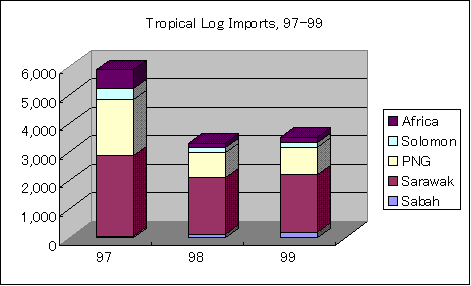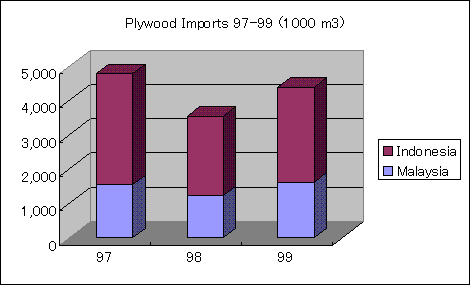
1999 Tropical Timber Imports to
Japan by Region
1. Logs
Imports of tropical hardwood logs in 1999 totalled 3.4 million m3, increasing
6.6% compared to 1998 imports, which were 39% less than 1997 imports.

This was the first increase in 10 years, but only a minor increase, due to
bankruptcies by Japanese plywood manufacturers and a transition to use of
tropical veneer or conifer logs rather than tropical hardwood logs as a raw
material for plywood production.
Housing starts also increased slightly (1.4% increase in total number, and
5.5% increase in total floor space compared to 1998)
By region, log imports increased 92.4% from Indonesia, which ended its ban on
log exports in an agreement with the IMF in 1998, and imports from Sabah,
Malaysia also increased 55.1%. Log imports from Sarawak increased only 1.9%,
partly due to a reduction of the export quota from 45% to 40% of total
production since July of 1999.
2. Plywood
Plywood imports increased dramatically (+24% compared to 1998) to 4.8 million
m3. Imports of Malaysian plywood reached an all-time peak of 1.6 million m3 due
partly to instable supplies of Indonesian plywood. Furthermore, it is noteworthy
that plywood imports from China, which overtook Japan to become the world's
number one importer of tropical hardwood logs in 1998, increased to 3 times the
1998 level.

Meanwhile, plywood manufactured in Japan is shifting towards use of conifer
wood. Conifer plywood and composite plywood (with alternating layers of tropical
and conifer veneer) together accounted for 41.5% of total production of ordinary
plywood, increasing 5.0 points from 1998. The increase in conifer plywood was
particularly high, whereas composite plywood production declined. Siberian larch
accounted for 71%, and radiata pine from New Zealand and Chile accounted for 20%
of the conifer wood used as a raw material for plywood.
Back to SCC English Homepage